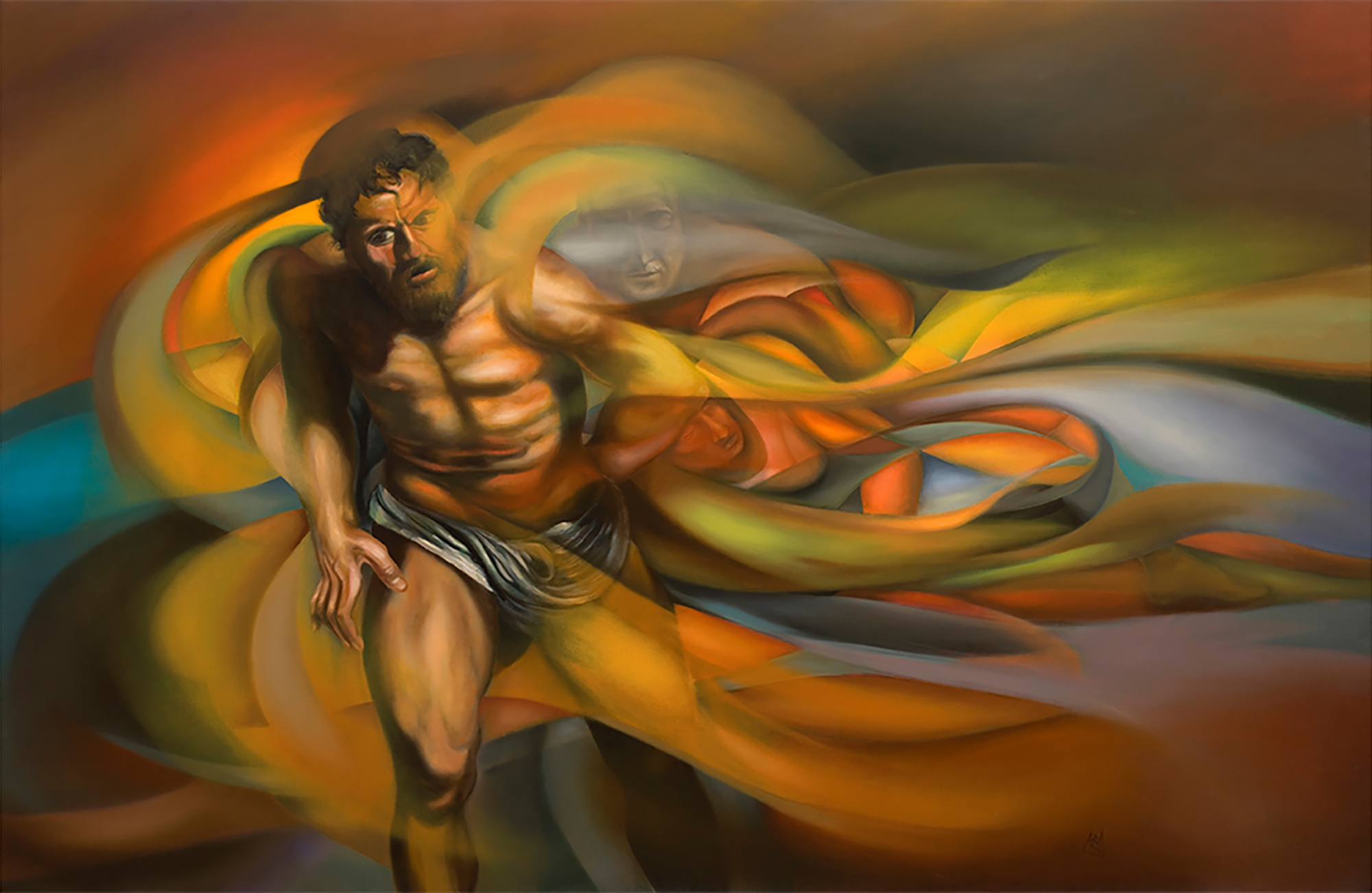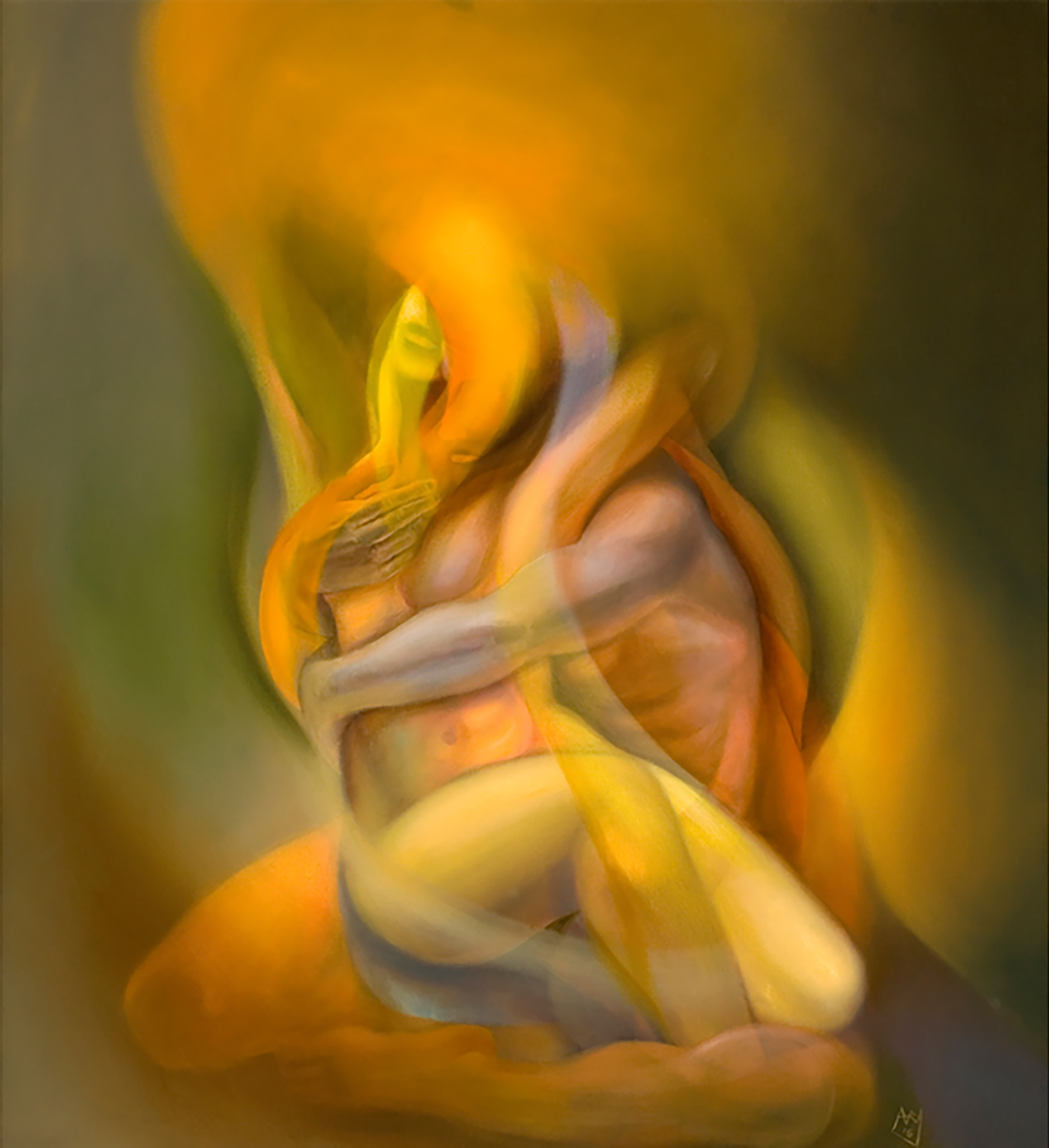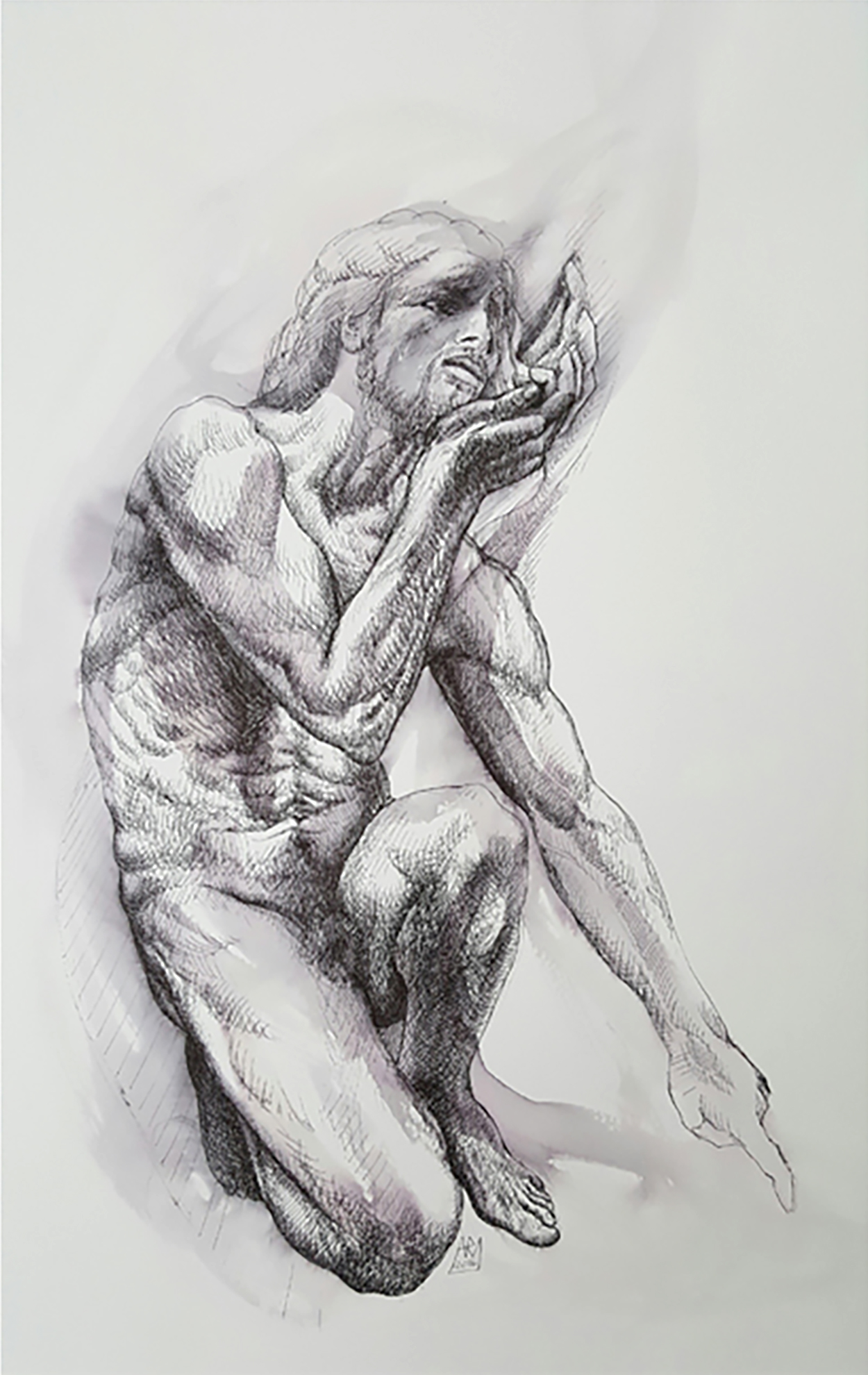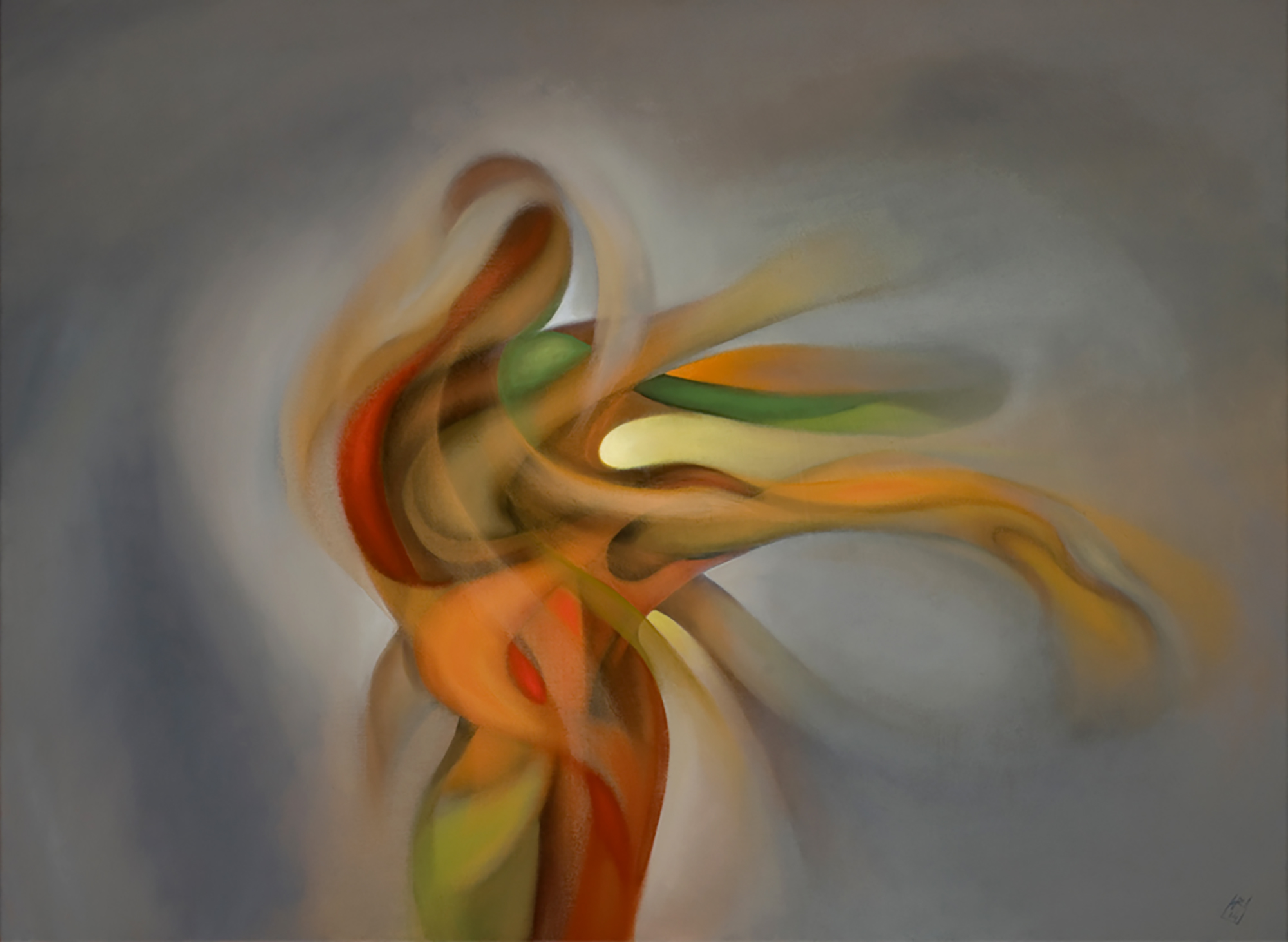Metralla Rosa con Carla Tofano

Watch Interview | Listen to Podcast
This interview was recorded on the 7th of June 2020 and released on the 1st of July 2020
Artists such as Armando Alemdar represent the archetype of the irreplaceable and unrepentant creator so well that it is impossible to imagine him doing anything else in life. For him, visual creation and intellectual reflection on art are inseparable experiences, both coexisting within him and his day-to-day life with unquestionable fluidity and naturalness.
Armando was born and raised in Macedonia, to a family that stimulated his creativity from the beginning, deliberately and unconsciously enriching and strengthening his interest in the arts and culture in thousands of ways. Perhaps for this reason it has proven to be relatively natural for Armando to create a deeply personal visual language, earning him a place on the international contemporary art market. And perhaps it is also for this that Armando studied Art History at Kingston University in London, becoming in turn a co-founder of the artistic movement Neomodernism, which lends a special relevance to the aesthetic and spiritual values present in an art work and which, guided by this philosophical and artistic vision, demands that the soul of the artwork be concentrated in the gaze.
This interview was recorded after the advice on social isolation due to Coronavirus was relaxed in the United Kingdom, and one of the more important aspects of the conversation was, without doubt, to discover just how seriously this disease had affected Armando’s health, and how his post Covid-19 work has been influenced by his illness.
The interview between Carla and Armando is full of reflections on both life and art. Between them they opened windows, dusted down deep memories and poured light onto sublime visions, something only the alchemy of good conversation can do, thanks to the miraculous properties of the spoken word. Hopefully you will feel the same and agree with these sentiments.
And now, enjoy the interview!
Related Links
Website | Instagram | Twitter | Wikipedia | Neomodernism
References during the interview
Neomodernism 00:41 | Sufism 01:00 | Ying & Yang 01:33 | Manifest 02:01 | Platonism 04:03 | Art Movement 05:08 | André Durand 06:00 | Plotinus 10:05 | Picasso 10:41 | Composition 12:34 | Modernism 12:50 | Macedonia 13:52 | Yugoslavia 16:28 | Socialism 16:30 | Whirling Dervish 19:53 | Dervish 21:48 | Titian 24:22 | Auguste Rodin 24:30 | Egon Schiele 24:42 | Gustav Klimt 24:44 | Renaissance 25:50 | Ancient Greece 35:53 | German Idealism 28:02 | Immanuel Kant 28:08 | Abstract Art 29:42 | Modernist Art 30:18 | Mark Rothko 31:35 | Figurative Art 34:02 | Expressionism 34:36 | 2008 Crisis 36:41 | German Expressionism 37:16 | Marxism 38:19 | Existentialism 41:18 | Enfant Terrible 41:33 | Vincent van Gogh 41:41 | Atelier 43:47 | Bauhaus 48:34 | Wassily Kandinsky 48:39 | Alexander Scriabin 48:42 | Transparent Glaze 49:44 | Goethe‘s Theory of Colours 50:25 | Mythology 52:10 | Greek Mythology 52:23 | Archetype 52:31 | Monotheism 53:20 | Hermes 53:22 | Jesus 53:23 | Mercury 53:39 | Icarus 54:25 | Coronavirus (Covid-19) 56:25 | A Dialectical Philosophy of Art 01:03:27 | Propaganda 01:04:32 | Soviet Art 01:04:35 | Religious Art 01:04:39 | Dogma 01:05:30 | GX Gallery 01:06:24 | Camberwell 01:06:26
Neomodernism is a movement in art that espouses spiritual and aesthetic values in art. Neomodernism is also a philosophy of art, a way of looking and creating a new relationship with works of art from the 15th to the 20th century. Neomodernism cuts through the media hype surrounding old master and modernist works of art, labels that have blinded the public – not to say made it hostile – to these works’ Neomodern message.
Image Credits: Cover photo by Nicolas Laborie | Armando with his father | Armando in his studio | Armando in his studio | Armando in his studio with Breakthrough 2014 | Portrait of Armando during exhibition by Nicolas Laborie | Portrait of Armando in blue room by Nicolas Laborie




St Anthony – Oil on linen, 2019 | Embrace – Oil on linen, 2017 | The Persuasion – Oil on linen, 2015 | Breakthrough – Oil on linen, 2015






Prometheus – Charcoal on watercolour paper, 2011 | Dancers – Pencil on paper, 2019 | Inner Seasons – Ink on paper, 2016 | Grandfather by Armando aged 17 – Pastel on paper, 1989 | Prometheus – Oil on linen, 2011 | Io – Oil on linen, 2016




Struggle – Conte crayon on watercolour paper, 2015 | Salome – Ink on watercolour paper, 2016 | Hope – Ink on paper, 2014 | Spring – Ink on paper, 2016






Spring II – Oil on linen, 2017 | Sufi – Ink on paper, 2015 | Ariadne – Ink on paper, 2011 | The Question – Ink on paper, 2015 | Memory – Oil on linen, 2014 | The Descent – Oil on linen, 2014





The Creation of Aphrodite – Oil on linen, 2009 | The Kiss – Oil on linen, 2010 | Embrace – Oil on linen, 2009 | Hermes – Oil on linen, 2016 | Abduction of Auropa – Oil on linen, 2011





Saviour – Oil on linen, c.2012 | Pandora – Oil on linen, 2012 | Job Transcending – Oil on linen, 2001 | Nucleus – Oil on linen, 2013 | Healing Energy – Oil on linen, 2016



Enigma – Oil on linen, 2014 | Spring: Persephone Leaving the Underworld (with André Durand) – Oil on linen, c.2002 | Apollo and Pan – Oil on linen, 2014





Lilith – Oil on linen, 2014 | The Call – Oil on linen, 2008 | Transfiguration – Oil on linen, 2003 | Zeus – Oil on linen, 2005 | Icarus – Oil on linen, 2012



Precipice – Oil on linen, 2020 | Saviour – Oil on linen, 2020 | One – Oil on linen, 2020
Guarda l’Intervista | Ascolta il Podcast
Questa intervista è stata registrata il 07 giugno 2020 e rilasciata il 01 luglio 2020
Artisti come Armando Alemdar rappresentano talmente bene l’archetipo del creativo inquieto e impenitente che è impossibile immaginarsi di vederlo fare altro nella vita che non quello che fa. Per lui la creazione pittorica e la riflessione intellettuale sull’arte sono esperienze inscindibili, ed entrambe convivono nel suo intimo e nella sua vita quotidiana con innegabile fluidità e naturalezza.
Armando è nato e cresciuto in Macedonia, in seno ad una famiglia che dal primo giorno che è arrivato in questo mondo ha stimolato la sua vocazione creativa, arricchendo e incoraggiando in mille modi – sia deliberatamente che inconsapevolmente – il suo interesse per le arti e la cultura. Forse per questo creare un linguaggio pittorico assolutamente personale, e conquistarsi un posto nel mercato dell’arte moderna internazionale, è stato relativamente naturale per Armando. E forse, sempre per questo motivo, ha studiato storia dell’arte a Londra, nell’Kingston University, diventando a sua volta il cofondatore di un movimento artistico, il Neomodernism, che attribuisce grande importanza ai valori estetici e spirituali di un’opera pittorica. Secondo questa visione artistico filosofica, si aspira a che l’anima dell’opera si concentri nell’occhio, sullo sguardo.
Abbiamo svolto questa intervista dopo che le misure per l’isolamento sociale di protezione contro il Coronavirus nel Regno Unito si erano allentate, e uno dei momenti più salienti dell’intervista è stato, sicuramente, scoprire quanto seriamente questo doloroso contagio abbia compromesso la salute di Armando, oltre allo scoprire quanto l’affrontare questo problema di salute stia influenzando i suoi lavori in corso post Covid-19.
Questa conversazione tra Carla e Armando è ricca di riflessioni sulla vita e sull’arte. Insieme sono riusciti a spalancare finestre, a rispolverare ricordi profondi e a illuminare visioni sublimi, che soltanto l’alchimia di una buona conversazione riesce a intrecciare grazie al miracolo della parola chiara. Ci auguriamo che viviate tutto ciò nella stessa maniera e che condividiate quest’impressione.
E adesso, godetevi l’intervista!
Link correlati
Website | Instagram | Twitter | Wikipedia | Neomodernism
Riferimenti durante l’intervista
Neomodernism 00:41 | Sufism 01:00 | Ying & Yang 01:33 | Manifest 02:01 | Platonism 04:03 | Art Movement 05:08 | André Durand 06:00 | Plotinus 10:05 | Picasso 10:41 | Composition 12:34 | Modernism 12:50 | Macedonia 13:52 | Yugoslavia 16:28 | Socialism 16:30 | Whirling Dervish 19:53 | Dervish 21:48 | Titian 24:22 | Auguste Rodin 24:30 | Egon Schiele 24:42 | Gustav Klimt 24:44 | Renaissance 25:50 | Ancient Greece 35:53 | German Idealism 28:02 | Immanuel Kant 28:08 | Abstract Art 29:42 | Modernist Art 30:18 | Mark Rothko 31:35 | Figurative Art 34:02 | Expressionism 34:36 | 2008 Crisis 36:41 | German Expressionism 37:16 | Marxism 38:19 | Existentialism 41:18 | Enfant Terrible 41:33 | Vincent van Gogh 41:41 | Atelier 43:47 | Bauhaus 48:34 | Wassily Kandinsky 48:39 | Alexander Scriabin 48:42 | Transparent Glaze 49:44 | Goethe‘s Theory of Colours 50:25 | Mythology 52:10 | Greek Mythology 52:23 | Archetype 52:31 | Monotheism 53:20 | Hermes 53:22 | Jesus 53:23 | Mercury 53:39 | Icarus 54:25 | Coronavirus (Covid-19) 56:25 | A Dialectical Philosophy of Art 01:03:27 | Propaganda 01:04:32 | Soviet Art 01:04:35 | Religious Art 01:04:39 | Dogma 01:05:30 | GX Gallery 01:06:24 | Camberwell 01:06:26
Il Neomodernismo è un movimento artistico che promuove i valori spirituali ed estetici nell’arte. Il Neomodernismo è anche una filosofia dell’arte, un modo di vedere e di creare una nuova relazione con le opere d’arte concepite tra i secoli XV e XX. Il Neomodernismo elude il clamore mediatico che circonda le opere dei vecchi maestri e dei modernisti, sfidando le etichette che hanno abbagliato il pubblico – per non dire reso ostile – per arrivare al messaggio Neomoderno di queste opere d’arte.
Crediti immagine: Cover photo by Nicolas Laborie | Armando with his father | Armando in his studio | Armando in his studio | Armando in his studio with Breakthrough 2014 | Portrait of Armando during exhibition by Nicolas Laborie | Portrait of Armando in blue room by Nicolas Laborie
Titoli: St Anthony – Oil on linen, 2019 | Embrace – Oil on linen, 2017 | The Persuasion – Oil on linen, 2015 | Breakthrough – Oil on linen, 2015 | Prometheus – Charcoal on watercolour paper, 2011 | Dancers – Pencil on paper, 2019 | Inner Seasons – Ink on paper, 2016 | Grandfather by Armando aged 17 – Pastel on paper, 1989 | Prometheus – Oil on linen, 2011 | Io – Oil on linen, 2016 | Struggle – Conte crayon on watercolour paper, 2015 | Salome – Ink on watercolour paper, 2016 | Hope – Ink on paper, 2014 | Spring – Ink on paper, 2016 | Spring II – Oil on linen, 2017 | Sufi – Ink on paper, 2015 | Ariadne – Ink on paper, 2011 | The Question – Ink on paper, 2015 | Memory – Oil on linen, 2014 | The Descent – Oil on linen, 2014 | The Creation of Aphrodite – Oil on linen, 2009 | The Kiss – Oil on linen, 2010 | Embrace – Oil on linen, 2009 | Hermes – Oil on linen, 2016 | Abduction of Auropa – Oil on linen, 2011 | Saviour – Oil on linen, c.2012 | Pandora – Oil on linen, 2012 | Job Transcending – Oil on linen, 2001 | Nucleus – Oil on linen, 2013 | Healing Energy – Oil on linen, 2016 | Enigma – Oil on linen, 2014 | Spring: Persephone Leaving the Underworld (with André Durand) – Oil on linen, c.2002 | Apollo and Pan – Oil on linen, 2014 | Lilith – Oil on linen, 2014 | The Call – Oil on linen, 2008 | Transfiguration – Oil on linen, 2003 | Zeus – Oil on linen, 2005 | Icarus – Oil on linen, 2012 | Precipice – Oil on linen, 2020 | Saviour – Oil on linen, 2020 | One – Oil on linen, 2020
Ve la Entrevista | Escucha el Podcast
Esta entrevista se grabó el 07 de junio de 2020 y publicada el 01 de julio de 2020
Artistas como Armando Alemdar, representan tan bien el arquetipo del creador impostergable e impenitente que es imposible imaginarlo haciendo cualquier otra cosa en la vida que no sea lo que hace. Para él la creación pictórica y la reflexión intelectual acerca del arte son experiencias indivisibles, y ambas conviven en su interior y en su día a día con una fluidez y una naturalidad inobjetables.
Armando nació y creció en Macedonia, en el seno de una familia que desde el día uno de su llegada a este mundo, estimuló su vocación creadora, enriqueciendo y fortaleciendo de mil formas – deliberadas e inconscientes – su interés por las artes y la cultura. Quizás por ello para Armando crear un lenguaje pictórico absolutamente personal y ganarse un espacio en el mercado del arte moderno internacional ha sido relativamente natural. Y quizás por ello también, Armando estudió historia del arte en Londres – en Kingston University – convirtiéndose a su vez en el co-fundador de un movimiento artístico, el Neomodernism, que otorga especial relevancia a los valores estéticos y espirituales presentes en una obra pictórica, y que aspira a que bajo esta vision artístico filosófica, se concentre el alma de la obra en el ojo, en la mirada.
Esta entrevista se llevó a cabo después de que las medidas en relación al aislamiento social de protección contra el Coronavirus comenzaron a flexibilizarse en el Reino Unido, y uno de los giros más importantes de la entrevista fue sin duda descubrir cuan gravemente este lamentable contagio afectó la salud de Armando, y descubrir lo mucho que atravesar este problema de salud ha estado influenciando su obra, en proceso de producción post Covid-19.
Esta conversación entre Carla y Armando estuvo llena de reflexiones acerca de la vida y el arte. Juntos lograron abrir ventanas, desempolvar memorias profundas e iluminar visiones sublimes, que solo la alquimia de una buena conversación logra entretejer gracias al milagro de la palabra clara. Ojalá ustedes lo vivan del mismo modo y coincidan con este sentimiento.
¡Y ahora, disfruten la entrevista!
Enlaces relacionados
Website | Instagram | Twitter | Wikipedia | Neomodernism
Menciones durante la entrevista
Neomodernism 00:41 | Sufism 01:00 | Ying & Yang 01:33 | Manifest 02:01 | Platonism 04:03 | Art Movement 05:08 | André Durand 06:00 | Plotinus 10:05 | Picasso 10:41 | Composition 12:34 | Modernism 12:50 | Macedonia 13:52 | Yugoslavia 16:28 | Socialism 16:30 | Whirling Dervish 19:53 | Dervish 21:48 | Titian 24:22 | Auguste Rodin 24:30 | Egon Schiele 24:42 | Gustav Klimt 24:44 | Renaissance 25:50 | Ancient Greece 35:53 | German Idealism 28:02 | Immanuel Kant 28:08 | Abstract Art 29:42 | Modernist Art 30:18 | Mark Rothko 31:35 | Figurative Art 34:02 | Expressionism 34:36 | 2008 Crisis 36:41 | German Expressionism 37:16 | Marxism 38:19 | Existentialism 41:18 | Enfant Terrible 41:33 | Vincent van Gogh 41:41 | Atelier 43:47 | Bauhaus 48:34 | Wassily Kandinsky 48:39 | Alexander Scriabin 48:42 | Transparent Glaze 49:44 | Goethe‘s Theory of Colours 50:25 | Mythology 52:10 | Greek Mythology 52:23 | Archetype 52:31 | Monotheism 53:20 | Hermes 53:22 | Jesus 53:23 | Mercury 53:39 | Icarus 54:25 | Coronavirus (Covid-19) 56:25 | A Dialectical Philosophy of Art 01:03:27 | Propaganda 01:04:32 | Soviet Art 01:04:35 | Religious Art 01:04:39 | Dogma 01:05:30 | GX Gallery 01:06:24 | Camberwell 01:06:26
El Neomodernismo es un movimiento en el arte que propugna los valores espirituales y estéticos en el arte. El Neomodernismo es también una filosofía del arte, una forma de mirar y crear una nueva relación con las obras de arte concebidas entre el siglo XV y XX. El Neomodernismo elude las exageraciones mediáticas que rodean las antiguas obras maestras y las modernistas, desafiando las etiquetas que han cegado al público, por no decir que lo han rendido hostil al mensaje Neomoderno presente en estas obras.
Créditos de las imágenes: Cover photo by Nicolas Laborie | Armando with his father | Armando in his studio | Armando in his studio | Armando in his studio with Breakthrough 2014 | Portrait of Armando during exhibition by Nicolas Laborie | Portrait of Armando in blue room by Nicolas Laborie
Títulos: St Anthony – Oil on linen, 2019 | Embrace – Oil on linen, 2017 | The Persuasion – Oil on linen, 2015 | Breakthrough – Oil on linen, 2015 | Prometheus – Charcoal on watercolour paper, 2011 | Dancers – Pencil on paper, 2019 | Inner Seasons – Ink on paper, 2016 | Grandfather by Armando aged 17 – Pastel on paper, 1989 | Prometheus – Oil on linen, 2011 | Io – Oil on linen, 2016 | Struggle – Conte crayon on watercolour paper, 2015 | Salome – Ink on watercolour paper, 2016 | Hope – Ink on paper, 2014 | Spring – Ink on paper, 2016 | Spring II – Oil on linen, 2017 | Sufi – Ink on paper, 2015 | Ariadne – Ink on paper, 2011 | The Question – Ink on paper, 2015 | Memory – Oil on linen, 2014 | The Descent – Oil on linen, 2014 | The Creation of Aphrodite – Oil on linen, 2009 | The Kiss – Oil on linen, 2010 | Embrace – Oil on linen, 2009 | Hermes – Oil on linen, 2016 | Abduction of Auropa – Oil on linen, 2011 | Saviour – Oil on linen, c.2012 | Pandora – Oil on linen, 2012 | Job Transcending – Oil on linen, 2001 | Nucleus – Oil on linen, 2013 | Healing Energy – Oil on linen, 2016 | Enigma – Oil on linen, 2014 | Spring: Persephone Leaving the Underworld (with André Durand) – Oil on linen, c.2002 | Apollo and Pan – Oil on linen, 2014 | Lilith – Oil on linen, 2014 | The Call – Oil on linen, 2008 | Transfiguration – Oil on linen, 2003 | Zeus – Oil on linen, 2005 | Icarus – Oil on linen, 2012 | Precipice – Oil on linen, 2020 | Saviour – Oil on linen, 2020 | One – Oil on linen, 2020